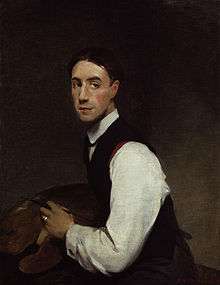Glyn Philpot

Glyn Warren Philpot RA (5 October 1884 – 16 December 1937) was an English painter and sculptor, best known for his portraits of contemporary figures such as Siegfried Sassoon and Vladimir Rosing.
Early life
Philpot was born in Clapham, London, but the family moved to Herne in Kent shortly afterwards. Philpot grew up to be both a gay man,[1] and a practising Christian who converted to Roman Catholicism.
Philpot studied at the Lambeth School of Art (now known as City and Guilds of London Art School) in 1900 where he was taught by Philip Connard, and at the Académie Julian in Paris.[2]
Career
%3B_The_Fitzwilliam_Museum.jpg)
Philpot first exhibited at the Royal Academy in 1904 and was elected to that establishment in 1923. He was a member of the International Society from 1913 and in that year he was awarded the gold medal at the Carnegie Institute, Pittsburgh.
He enjoyed a "comfortable income" from portraiture. He was reported as doing ten or twelve commissions a year, charging between £600 and £3,000 a time.[3] This enabled him to afford to travel to France, Italy, America and North Africa and continue to paint less commercially successful subject pictures. Following the Symbolist tradition his subject pictures reflected more personal concerns and contradictions: Philpot converted to Catholicism, yet his interest in the male nude and portraits of young men – thought to be friends, models and lovers – show his gradual acceptance and expression of his own homosexuality.[3] Some of these later works were considered controversial because of their homosexual imagery. Two pieces in particular – Guardian of the Flame and The Great Pan (1930) were withdrawn from the Royal Academy. This led to a loss of popularity which caused him financial hardship.[3]
Exhibitions have been held at The Tate Gallery (1938), The Ashmolean Museum, The National Portrait Gallery, of which he was a founder member in 1911, and Pallant House Gallery. Philpot was a member of the International Society of Sculptors, Painters and Gravers.[4]
Personal life

Philpot was in a relationship with painter Vivian Forbes from 1923–1935.[5] A loving cup held by Brighton Museum serves as a testament to their relationship.[6] Philpot died from a stroke in December 1937; his funeral took place on 22 December 1937. Forbes committed suicide the following day.[6] He is buried in a pink granite tomb in St. Peter's Churchyard, Petersham.[7]
Works
Sources
- Delaney, J. G. P. (1999) Glyn Philpot: His Life and Art, Ashgate Publishing
- Gibson, Robin (1986) Glyn Philpot, 1884–1937: Edwardian Aesthete to Thirties Modernist, National Portrait Gallery, London
References
- ↑ "Monday Book: A charmed life tinged with pain". The Independent. The Independent. Retrieved 25 November 2017.
- ↑ Oxford index, Benezit Dictionary of Artists
- 1 2 3 Glyn Philpot (Exhibition catalogue). London: The Fine Art Society. 1997. pp. 7–12.
- ↑ "The International Society of Sculptors, Painters and Gravers". Mapping the Practice and Profession of Sculpture in Britain and Ireland 1851–1951. Glasgow University. Retrieved 31 May 2013.
- ↑ Freyberg, Annabel (20 June 1999). "Monday Book: A charmed life tinged with pain". The Independent. Retrieved 23 January 2016.
- 1 2 "A Bittersweet Loving Cup". Discover. Retrieved 22 May 2016.
- ↑ Who's Buried Where in London, by Peter Matthews, Bloomsbury Publishing, 23 Mar 2017, pg 242
External links
| Wikimedia Commons has media related to Glyn Warren Philpot. |